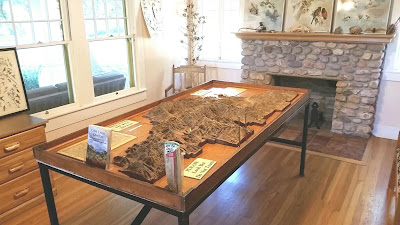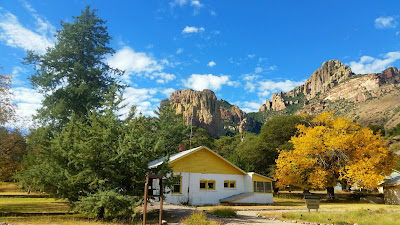We first visited Cave Creek Canyon last spring for about 6 weeks starting at the end of April. We liked it so much we decided to come back for November and the Fall Colors in southeast Arizona.
The nearest town is Portal, AZ. Life in Portal is pretty basic, a lodge/cafe/store, post office (open 9-12 six days a week) and a library with a great selection of DVD's, no TV reception. A lady's club called "Sew What" presents programs once or twice a month as fund raisers. They sponsor college scholarships for local high school seniors and support a nursing home in Douglas, AZ. We attended 2 programs while we were here. One was by a couple that took a trip to South Africa, and the other was a local resident who's a professor at the University of Southern Arizona on the solar electric revolution.
Our job (then and now) is working the Visitors Information Center (aka The VIC) helping visitors enjoy this wonderful oasis in the desert. The building was constructed in 1927 as a ranger station/residence. It's gone through many transformations over the years and in recent decades was unused till 2004 when the Rotary Club from Tucson renovated the old station.
Even after the renovation it lay dormant until the Friends of Cave Creek Canyon entered into an agreement with the US Forest Service to open a visitors center. By all accounts it's been a great success. We often get long time visitors who are thrilled that the old ranger station is open again.
 |
| Joan, ready to help someone find a great campsite, hiking trail or birding locations. |
The Canyon is part of the Chiricahua mountian range, one of a series of "Sky Islands" located throughout southeastern Arizona, southwestern New Mexico and northern Mexico.
This hour long video describes everything you ever wanted to know about the Chiricahua mountains. The first 2:50 minutes are previews of other videos by the film maker followed by the feature presentation. Watching the video from 2:50 to 14:00 will give a good basic understanding of the Sky Islands. The rest of the video describes the plants and animals found in the Chiricahuas.
The first time I saw the below relief map of the Chiricahuas, I thought it was produced with a 3-D printer. With closer examination it became clear it's origin was much more low-tech. It was hand-made in 1940 by members of the Works Progress Administration (WPA), part of the New Deal.
 |
| Pointing to the Visitors Center location. |
Each contour line was cut into the veneer forming one layer. The procedure continued for each contour line. Once cut, each layer was laid on the previous layer, building to the highest elevation.
 |
| This is our hiking trail map. We can print detailed description of trails as shown below the map in the above picture.. |
Coming next, Fall colors in the Chiricahuas.







